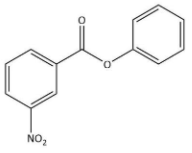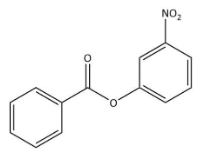
Nitration of phenyl benzoate yields the product:
A)

B)

C)

D)





Answer
578.1k+ views
Hint: We know that the presence of electron withdrawing groups such as ${NO}_{2}$, ${CN}$ etc. at o-and p-positions but not at m-positions with respect to the halogen greatly activates the halogen towards nucleophilic displacement. We also know that the number of such groups at o- and p-positions with respect to the halogens varies directly with the reactivity of the haloarene.
Complete answer:
We know that the ring which is attached to the O- atom, in that the nitro group enters and as the result of it $\text C_{6}\text H_{5}\text {COO}-$ group gets activated. It is known that it will not get into the ring to which the carbonyl group as it will deactivate the $\text C_{6}\text H_{5}\text {COO}-$ group. We can now say that the $\text C_{6}\text H_{5}\text {COO}-$ group is ortho and para directing in nature.
The chemical equation that represents the formation of 4-nitrophenyl benzoate is shown as follows.

Thus, we can conclude the nitration of phenyl benzoate yields 4-nitrophenyl benzoate.
Hence, we can conclude that the correct option is B.
Note: We know that the presence of electron withdrawing groups at o- and p-position but not at m-positions with respect to the halogens activates the aryl halides towards nucleophilic substitution reactions. The number of nitro groups at o- and p-positions increases, the stabilization of the resulting carbanion increases due to more resonating structures which results in the greater reactivity of the corresponding aryl halide.
Complete answer:
We know that the ring which is attached to the O- atom, in that the nitro group enters and as the result of it $\text C_{6}\text H_{5}\text {COO}-$ group gets activated. It is known that it will not get into the ring to which the carbonyl group as it will deactivate the $\text C_{6}\text H_{5}\text {COO}-$ group. We can now say that the $\text C_{6}\text H_{5}\text {COO}-$ group is ortho and para directing in nature.
The chemical equation that represents the formation of 4-nitrophenyl benzoate is shown as follows.

Thus, we can conclude the nitration of phenyl benzoate yields 4-nitrophenyl benzoate.
Hence, we can conclude that the correct option is B.
Note: We know that the presence of electron withdrawing groups at o- and p-position but not at m-positions with respect to the halogens activates the aryl halides towards nucleophilic substitution reactions. The number of nitro groups at o- and p-positions increases, the stabilization of the resulting carbanion increases due to more resonating structures which results in the greater reactivity of the corresponding aryl halide.
Recently Updated Pages
The number of solutions in x in 02pi for which sqrt class 12 maths CBSE

Write any two methods of preparation of phenol Give class 12 chemistry CBSE

Differentiate between action potential and resting class 12 biology CBSE

Two plane mirrors arranged at right angles to each class 12 physics CBSE

Which of the following molecules is are chiral A I class 12 chemistry CBSE

Name different types of neurons and give one function class 12 biology CBSE

Trending doubts
One Metric ton is equal to kg A 10000 B 1000 C 100 class 11 physics CBSE

Explain zero factorial class 11 maths CBSE

What is 1s 2s 2p 3s 3p class 11 chemistry CBSE

Discuss the various forms of bacteria class 11 biology CBSE

State the laws of reflection of light

An example of chemosynthetic bacteria is A E coli B class 11 biology CBSE




